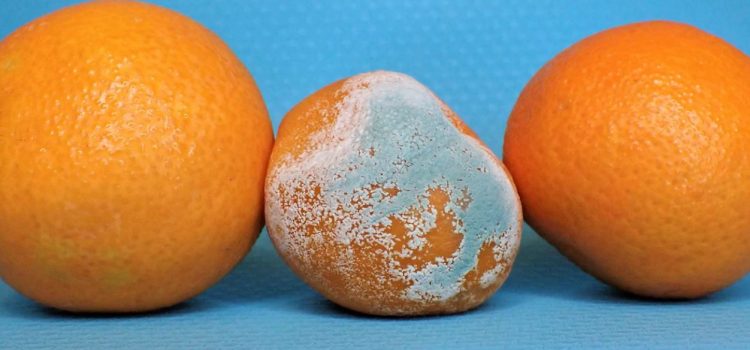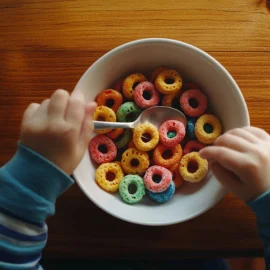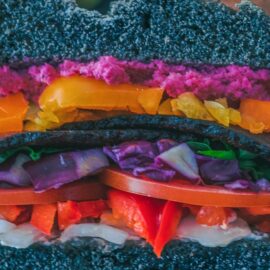
This is a free excerpt from one of Shortform’s Articles. We give you all the important information you need to know about current events and more.
Don't miss out on the whole story. Sign up for a free trial here .
Is it okay to eat old bread if you cut the moldy part off? Is the red juice from steak really blood? What foods can you eat beyond their expiration dates?
A viral food disgust test called the Food Disgust Sensitivity Test has people debating whether some foods can turn your stomach—or literally make you sick. While the test is amusing to take, it’s important to know what foods you should actually be avoiding.
From moldy bread and jam to yogurt past its use-by date, keep reading to learn what the experts say about what you can safely eat.
Are Some Foods a Matter of Preference—or a Question of Health and Safety?
Move over, Myers-Briggs personality test, there’s a new viral quiz in town: the Food Disgust Sensitivity Test. How it works: It presents you with a statement, such as “It is sickening to eat bread from which mold has been cut away,” and you then indicate how strongly you agree or disagree. Your answers to the 32 questions are used to calculate your sensitivity to eight categories, including animal flesh, mold, and hygiene.
The test is based on the work of two consumer behavior professors, but it’s worth noting that it’s not endorsed by those professors; nor is the test based on science.
That being said, there are some things in the test that you should avoid because they can literally make you sick, putting you at risk for food poisoning.
Mold
One of the biggest debates after the test went viral was whether it’s OK to simply remove the moldy part of food and eat the rest of it.
First, the basics: Molds are fungi that look like microscopic mushrooms—they have root threads, stalks that peek out of food, and spores at the end of the stalks, giving mold that fuzzy green or white appearance. According to the US Department of Agriculture (USDA), the danger of ingesting mold is that some types can lead to allergic reactions, while a few can produce toxic compounds like mycotoxins that lead to food poisoning. But are you safe if you cut out the moldy bits?
When It’s Not Safe
By the time you see mold growing on food, its roots have already spread beneath the surface. This is especially true for porous foods like bread and jam as well as soft fruits and vegetables like tomatoes and berries. So in these cases, it’s best to toss the whole item, even if you only spot a tiny bit of mold on the surface of a newly opened jar of jam.
In some cheeses, mold is deliberately grown to give them a distinctive flavor: Roquefort, Gorgonzola, and blue cheese are pungent varieties of cheese with characteristic blue veins running through them. The problem is when other types of mold start invading these and other soft cheeses. Once you see a kind of mold that isn’t supposed to be there, throw the cheese out.
When It’s Safe
For hard cheeses, the rules are different: The USDA says they should be OK to consume after cutting off at least an inch around the moldy portion, making sure that your knife doesn’t touch the mold to prevent cross-contamination. The same rule applies to firm fruits and vegetables like bell peppers and carrots.
A Word From the Experts
If you do end up accidentally ingesting the undesirable, non-blue cheese kind of mold, don’t panic. With a healthy immune system, you should be able to digest it. Experts say there’s no need to seek medical help unless you experience symptoms.
“Bloody” Meat
Another statement in the Food Disgust Test is, “I do not like to eat steak that is still bloody inside.” First, it’s worth noting that the statement isn’t accurate: The red juices you see in your steak aren’t blood at all but a mix of water and a protein called myoglobin.
Semantics aside, the USDA recommends an internal temperature of at least 145°F, which lies within the range for medium steaks. However, most chefs recommend cooking steaks to medium-rare (internal temperature of 130-135°F) for maximum juiciness and flavor.
Burgers Are a Different Matter
What’s not debatable is raw or undercooked ground beef—since the meat is ground up, the bacteria on the surface ends up being distributed throughout the mince. So when it comes to meatloaf, burgers, and meatballs, “bloody” isn’t a good idea; cook them to an internal temperature of 160°F.
Cookie Dough
While not part of the Food Disgust Test, cookie dough has long been a topic of debate, with the health authorities, on one side, warning against its dangers and pretty much everyone else on the other, defending its deliciousness. In spring 2023, the US Centers for Disease Control and Prevention (CDC) reminded everyone to forgo eating raw cookie dough after 18 people suffered from a salmonella outbreak linked to the stuff.
According to the CDC, the problem with raw cookie dough is that it contains uncooked flour, which has germs like E. coli and salmonella—both of which cause food poisoning. Raw cookie dough also contains raw eggs, which may carry salmonella too.
Expired Food
Another item that isn’t in the test is food past its expiration date. The US Food and Drug Administration estimates that Americans dispose of $161 billion worth of food each year, with 20% of that thrown out because consumers are confused by the dates on food labels. The confusion stems from inconsistent or unclear labeling: phrases like “sell by,” “use by,” best if used by,” and “enjoy by.” As a result, people are throwing out food that’s still perfectly safe and edible.
The next time you clean out your pantry and fridge, remember that dates on food labels are usually an indication of quality not safety—that cereal at the back of your shelf may taste a little stale, but it still should be fine to eat. Canned goods can be stored indefinitely as long as the cans aren’t rusted or swollen. Yogurt may be OK up to a month after its “best by” date if it remains unopened. (The exception is when the yogurt has fruit at the bottom—a breeding ground for mold.) If you’re unsure, your best bet may be to rely on something we humans have used for ages: our senses. If something looks, smells, or tastes off, toss it.

Want to fast-track your learning? With Shortform, you’ll gain insights you won't find anywhere else .
Here's what you’ll get when you sign up for Shortform :
- Complicated ideas explained in simple and concise ways
- Smart analysis that connects what you’re reading to other key concepts
- Writing with zero fluff because we know how important your time is






